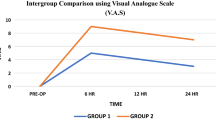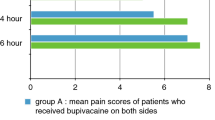Abstract
Perioperative local anaesthetics are often used to reduce the postoperative pain in tonsillectomy. There exist three different ways of applying local anaesthetics: (1) pre-incisional peritonsillar; (2) post-tonsillectomy wound infiltration; (3) post-tonsillectomy packing with soaked gauze. The objective of the study is the evaluation of differences of pain reduction comparing the three different techniques of application. The study design mainly includes intra-individual, prospective and double-blinded. One hundred and eighty patients (3–45 years) with recurrent tonsillitis were included. The charts of 156 were eligible for analysis. Bupivacaine was applied on both sides randomized in different ways. Pain on each side was registered for 6 days on the ward by a blinded nurse. When directly compared with the other two application methods, the post-tonsillectomy injection of bupivacaine provides significantly better results during the monitored time period. Postoperative bleeding was observed in 11 (7.3%) cases without any correlation to an application procedure. No other adverse effects were observed. In conclusion, post-tonsillectomy infiltration of the wounds with bupivacaine is superior to pre-incisional infiltration technique as well as post-tonsillectomy packing of the wounds with 0.5% bupivacaine-soaked gauze swab.





Similar content being viewed by others
References
Dal D, Celebi N, Elvan EG, Celiker V, Aypar U (2007) The efficacy of intravenous or peritonsillar infiltration of ketamine for postoperative pain relief in children following adenotonsillectomy. Paediatr Anaesth 17(3):263–269. doi:10.1111/j.1460-9592.2006.02095.x
Freeman SB, Markwell JK (1992) Sucralfate in alleviating post-tonsillectomy pain. Laryngoscope 102(11):1242–1246. doi:10.1288/00005537-199211000-00007
Johansen M, Harbo G, Illum P (1996) Preincisional infiltration with bupivacaine in tonsillectomy. Arch Otolaryngol Head Neck Surg 122(3):261–263
Hollis LJ, Burton MJ, Millar JM (2000) Perioperative local anaesthesia for reducing pain following tonsillectomy. Cochrane Database Syst Rev (2):CD001874
Goldsher M, Podoshin L, Fradis M, Malatskey S, Gerstel R, Vaida S et al (1996) Effects of peritonsillar infiltration on post-tonsillectomy pain. A double-blind study. Ann Otol Rhinol Laryngol 105(11):868–870
Jebeles JA, Reilly JS, Gutierrez JF, Bradley EL Jr, Kissin I (1991) The effect of pre-incisional infiltration of tonsils with bupivacaine on the pain following tonsillectomy under general anesthesia. Pain 47(3):305–308. doi:10.1016/0304-3959(91)90220-R
Kountakis SE (2002) Effectiveness of perioperative bupivacaine infiltration in tonsillectomy patients. Am J Otolaryngol 23(2):76–80. doi:10.1053/ajot.2002.28771
Wong AK, Bissonnette B, Braude BM, Macdonald RM, St-Louis PJ, Fear DW (1995) Post-tonsillectomy infiltration with bupivacaine reduces immediate postoperative pain in children. Can J Anaesth 42(9):770–774
Kadar AA, Obaid MA (2003) Effect on postoperative pain after local application of bupivacaine in the tonsillar fossa; a prospective single blind controlled trial. J Pak Med Assoc 53(9):422–426
Park AH, Pappas AL, Fluder E, Creech S, Lugo RA, Hotaling A (2004) Effect of perioperative administration of ropivacaine with epinephrine on postoperative pediatric adenotonsillectomy recovery. Arch Otolaryngol Head Neck Surg 130(4):459–464. doi:10.1001/archotol.130.4.459
Jebeles JA, Reilly JS, Gutierrez JF, Bradley EL Jr, Kissin I (1993) Tonsillectomy and adenoidectomy pain reduction by local bupivacaine infiltration in children. Int J Pediatr Otorhinolaryngol 25(1–3):149–154. doi:10.1016/0165-5876(93)90048-8
Sorensen WT, Wagner N, Aarup AT, Bonding P (2003) Beneficial effect of low-dose peritonsillar injection of lidocaine-adrenaline before tonsillectomy. A placebo-controlled clinical trial. Auris Nasus Larynx 30(2):159–162. doi:10.1016/S0385-8146(03)00047-6
Williamson A, Hoggart B (2005) Pain: a review of three commonly used pain rating scales. J Clin Nurs 14(7):798–804. doi:10.1111/j.1365-2702.2005.01121.x
Sloman R, Wruble AW, Rosen G, Rom M (2006) Determination of clinically meaningful levels of pain reduction in patients experiencing acute postoperative pain. Pain Manag Nurs 7(4):153–158. doi:10.1016/j.pmn.2006.09.001
Somdas MA, Senturk M, Ketenci I, Erkorkmaz U, Unlu Y (2004) Efficacy of bupivacaine for post-tonsillectomy pain: a study with the intra-individual design. Int J Pediatr Otorhinolaryngol 68(11):1391–1395. doi:10.1016/j.ijporl.2004.05.006
Hultcrantz E, Linder A, Markstrom A (2005) Long-term effects of intracapsular partial tonsillectomy (tonsillotomy) compared with full tonsillectomy. Int J Pediatr Otorhinolaryngol 69(4):463–469. doi:10.1016/j.ijporl.2004.11.010
Noordzij JP, Affleck BD (2006) Coblation versus unipolar electrocautery tonsillectomy: a prospective, randomized, single-blind study in adult patients. Laryngoscope 116(8):1303–1309. doi:10.1097/01.mlg.0000225944.00189.e9
Brown PM (2006) How safe is paediatric tonsillectomy? Int J Pediatr Otorhinolaryngol 70(4):575–577. doi:10.1016/j.ijporl.2005.12.006
Rasgon BM, Cruz RM, Hilsinger RL Jr, Korol HW, Callan E, Wolgat RA et al (1991) Infiltration of epinephrine in tonsillectomy: a randomized, prospective, double-blind study. Laryngoscope 101(2):114–118. doi:10.1288/00005537-199102000-00002
Nikandish R, Maghsoodi B, Khademi S, Motazedian S, Kaboodkhani R (2008) Peritonsillar infiltration with bupivacaine and pethidine for relief of post-tonsillectomy pain: a randomised double-blind study. Anaesthesia 63(1):20–25. doi:10.1111/j.1365-2044.2007.05283.x
Unal Y, Pampal K, Korkmaz S, Arslan M, Zengin A, Kurtipek O (2007) Comparison of bupivacaine and ropivacaine on postoperative pain after tonsillectomy in paediatric patients. Int J Pediatr Otorhinolaryngol 71(1):83–87. doi:10.1016/j.ijporl.2006.09.005
Akoglu E, Akkurt BC, Inanoglu K, Okuyucu S, Dagli S (2006) Ropivacaine compared to bupivacaine for post-tonsillectomy pain relief in children: a randomized controlled study. Int J Pediatr Otorhinolaryngol 70(7):1169–1173. doi:10.1016/j.ijporl.2005.12.001
Ginstrom R, Silvola J, Saarnivaara L (2005) Local bupivacaine-epinephrine infiltration combined with general anesthesia for adult tonsillectomy. Acta Otolaryngol 125(9):972–975. doi:10.1080/00016480510043413
Author information
Authors and Affiliations
Corresponding author
Rights and permissions
About this article
Cite this article
Stelter, K., Hempel, J.M., Berghaus, A. et al. Application methods of local anaesthetic infiltrations for postoperative pain relief in tonsillectomy: a prospective, randomised, double-blind, clinical trial. Eur Arch Otorhinolaryngol 266, 1615–1620 (2009). https://doi.org/10.1007/s00405-008-0909-0
Received:
Accepted:
Published:
Issue Date:
DOI: https://doi.org/10.1007/s00405-008-0909-0




